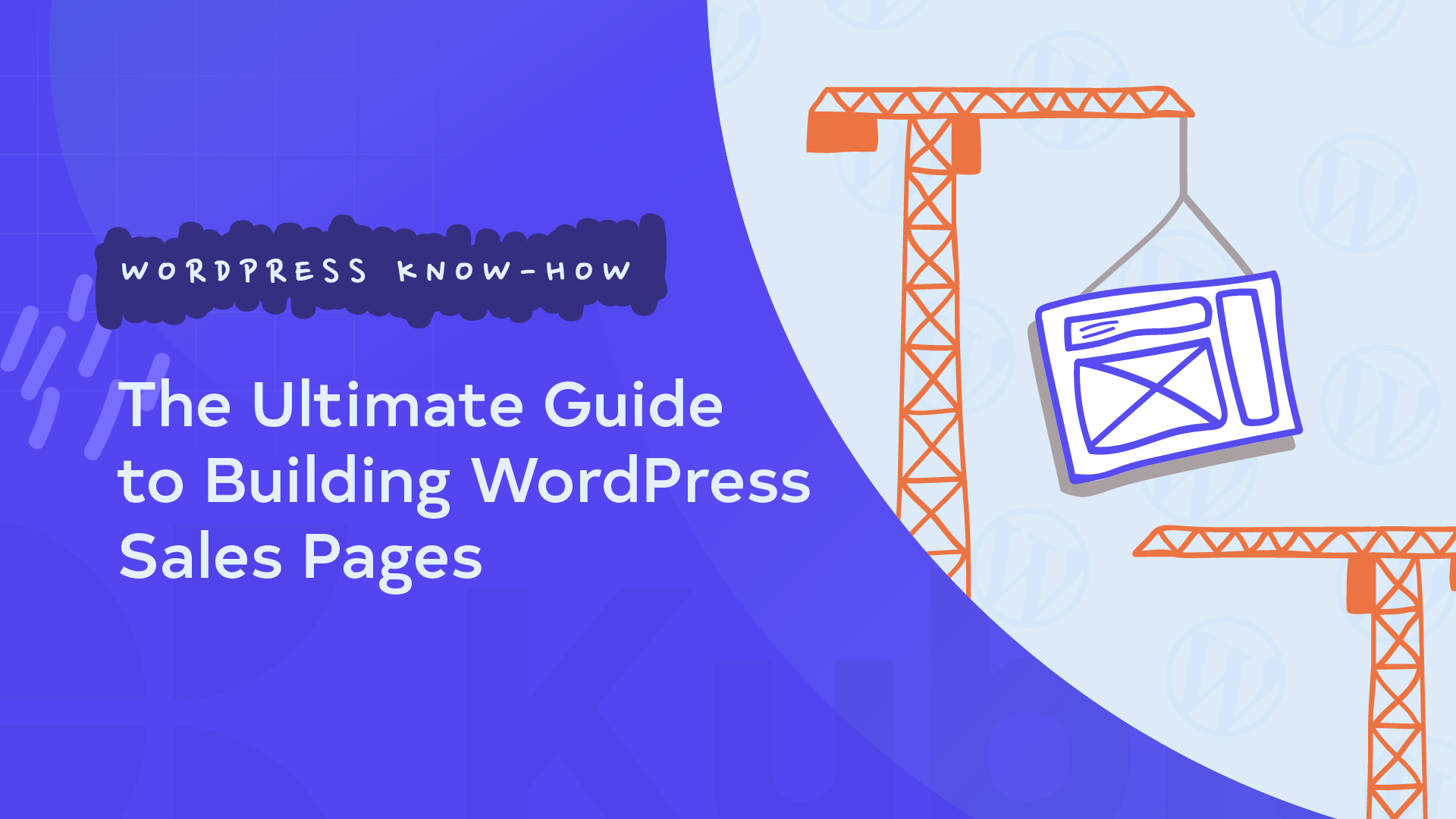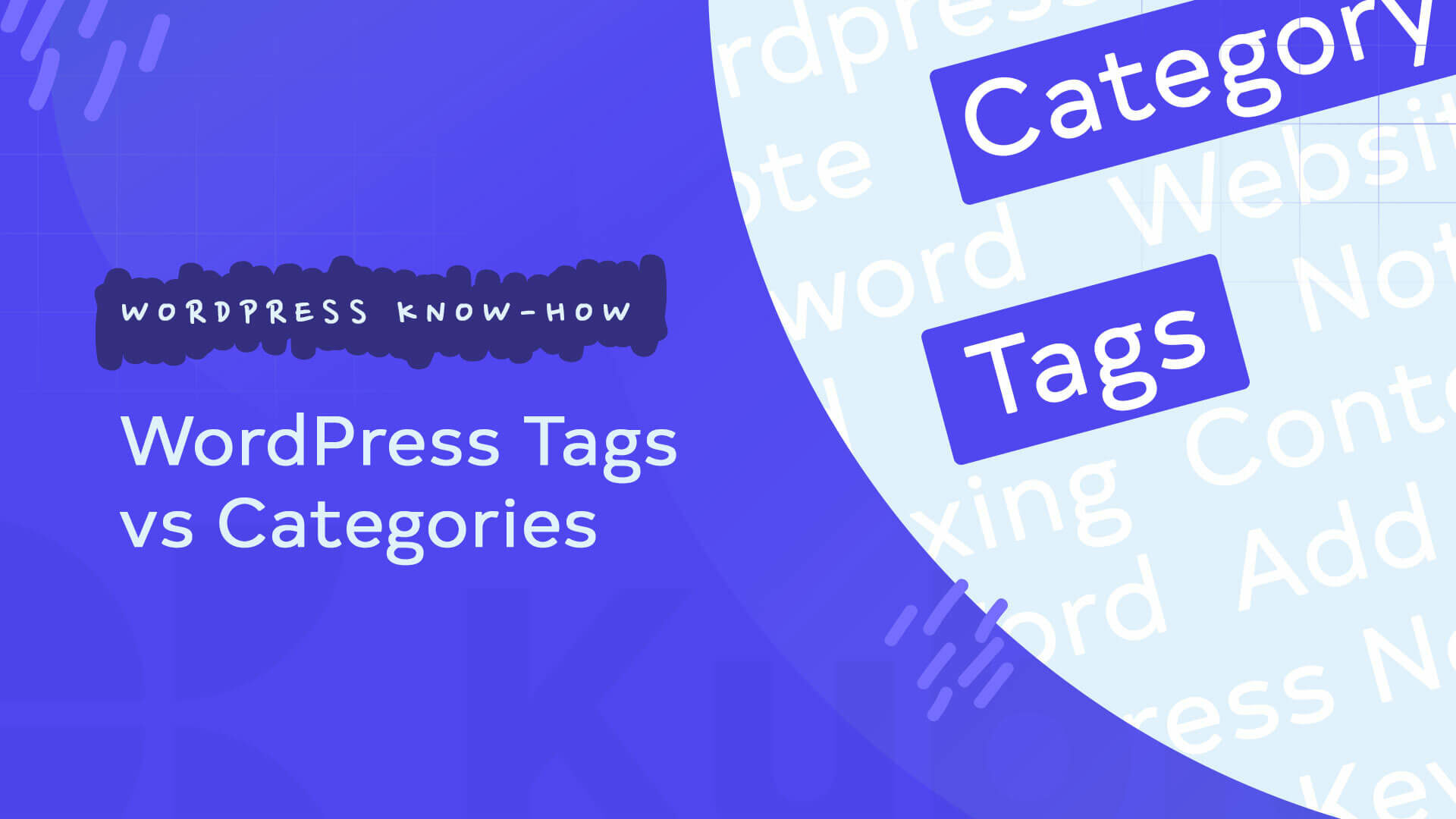A well-crafted sales page can make the difference between a casual visitor and a loyal customer. However, creating a compelling sales page can seem overwhelming. It’s more than just showcasing your products or services; it’s about creating an attractive, intuitive, and effective user experience that guides your visitors through your sales funnel.
Fortunately, with the right tools and guidance, it’s a task you can tackle with confidence and ease. In this comprehensive guide, we’ll explore how a well-crafted sales page can be a game-changer for your online business.
We’ll even walk you through the process of building your first sales page using Kubio – an intuitive and user-friendly WordPress web builder that can help you create a stunning and effective sales page, even without a background in web design or coding.
From choosing the right theme to crafting the perfect call-to-action, we’ll cover it all while sharing valuable tips on optimizing your sales page for speed, mobile-friendliness, and performance tracking.
Let’s get started!
Understanding the importance of the sales page
A sales page is a standalone page designed with one purpose: securing sales for your product or service. It’s a platform where you can showcase the unique selling points of your product or service, address potential customers’ pain points, and offer your solution.
In essence, a sales page is a powerful tool in your marketing arsenal, helping you attract more customers, increase sales, and ultimately, grow your business.
Even better, a sales page can bring in impressive conversion rates. While the average conversion rate for a typical website is around 2-5%, a well-constructed sales page can skyrocket this figure to over 10%. That’s a significant increase!
Here are more reasons why sales pages matter:
- Making a strong first impression: Your sales page is often the first point of contact between your business and potential customers. A well-designed, professional-looking sales page can leave a lasting impression, encouraging visitors to explore further.
- Explaining your offer: A sales page presents an excellent opportunity to explain what you’re selling and why it’s necessary. It’s your platform to showcase how your product or service solves a problem, fills a need, or provides value to the customer.
- Highlighting product features: By clearly showing off the best and most useful features of your product or service and their benefits, you can help potential customers understand why they should choose your product over others.
- Answering customer questions: A well-crafted sales page anticipates and answers questions that customers may have about your product or service. This proactive approach can help remove any doubts or reservations, paving the way for a purchase.
- Convincing people to buy: Through compelling copy, engaging visuals, and persuasive calls-to-action (CTA), you can guide visitors toward a buying decision.
- Building trust: Incorporating elements like customer testimonials, reviews, and security badges on your sales page builds trust with potential customers and reassures them of your credibility.
- Guiding visitors down the sales funnel: Designed to attract, engage, and convert visitors, sales pages steer your customers further down the funnel toward a purchase.
- Collecting contact information: A sales page can also serve as a lead generation tool. By offering something of value in exchange for contact information, such as a free trial or a downloadable guide, you can build your email list and run targeted email marketing campaigns.
While sales pages present an incredible opportunity to boost your business, it’s vital to build a page that’s designed to help you reach your goals.
A poorly designed sales page can do more harm than good, turning off potential customers and hurting your brand image. That’s why it’s essential to put in the time and effort to create a sales page that effectively communicates your value proposition, engages visitors, and drives conversions.
The essential elements of an effective WordPress sales page
An effective sales page does more than look good; it’s a well-thought-out blend of advantageous elements that meet the following criteria:
- Explains your product or service: Explaining your products or services involves detailing their features, benefits, and how they work. Make sure your explanation is easy to understand and focuses on how your product or service can solve a problem or add value to the customer’s life.
- Start by clearly defining your product or service. Use simple and concise language, and ensure that your explanation is prominently displayed on your website or sales page.
- List the key features that make your products or services unique or valuable.
- Explain the benefits customers will receive from using your product or service. Focus on how it can solve their problems or improve their lives.
- Use visuals like images, videos, or infographics to supplement your explanation and make it more engaging.
- Identifies why and to whom it is useful: This helps potential customers understand if your product or service is right for them, and it can help you attract the right audience to your page.
- Create a buyer persona to understand your target audience better. Know their needs, pain points, and preferences.
- Tailor your messaging to speak directly to your ideal customer. Use language that resonates with them.
- Clearly state who your product or service is designed for. For example, “Our software is designed for small businesses looking to streamline their operations”.
- Use testimonials or case studies that showcase how your products/services have benefited similar customers.
- Compels readers to make a purchase: Your sales page should entice visitors to make a purchase through strong CTAs and other means. For example:
- Use encouraging phrasing like “Buy Now!”, “Get Started!”, or “Sign Up Today!”.
- Depending on your product or service, you might include an opt-in form to send customers more information.
- Make sure your CTAs stand out visually with contrasting colors and clear placement on the page.
- Consider using scarcity tactics (e.g., limited stock, limited-time offers) to create a sense of urgency.
You can easily achieve the above points by implementing these key facets:
Intuitive site and page navigation
An effective sales page should be easy to navigate. This includes having:
- Clear and intuitive site structure.
- Easy-to-find information.
- Smooth navigation between pages.
Kubio offers user-friendly starter sites with captivating landing pages that make page navigation effortless and instinctive.
Compelling page titles and headings
Page titles and headings should grab the visitor’s attention and guide them through your sales page. Compelling, concise, and clear copy here will broadcast the main points of your page.
Clear and persuasive marketing copy
Effective marketing copy plays a pivotal role in conveying the essence of your products or services, illuminating their numerous advantages, and motivating readers to take the decisive step of making a purchase.
Try to use simple language so that even the most casual reader can understand the message.
Eye-catching photos and graphics
Visual elements like photos and graphics can greatly enhance your sales page. They can grab attention, convey information visually, and evoke emotions that can drive sales.
Trust-building elements
Trust is the currency that fuels successful transactions online. Incorporating elements such as reviews and testimonials into your sales page serves as a powerful trust-building strategy, which, in turn, can significantly enhance your sales conversion rates.
By showcasing these endorsements prominently on your sales page, you provide potential customers with tangible evidence of your product or service’s value.
To maximize the impact of reviews and testimonials, consider strategically placing them within your sales page’s content flow. Feature them alongside relevant product or service descriptions to reinforce the benefits you want to highlight.
Strong CTAs
CTAs serve as the guiding beacon for your visitors, guiding them toward the choices that help you reach your business goals.
Whether you want to drive purchases, gather newsletter subscribers, or increase downloads of valuable resources like guides and eBooks, effective CTAs go beyond mere buttons or links. They are the persuasive instruments that bridge the gap between visitor interest and engagement.
Use clear and captivating language that addresses the needs, desires, and pain points of your target audience. A great CTA should inspire action.
Step-by-step guide to building a WordPress sales page with Kubio
Building a successful WordPress sales page might seem like a daunting task, but Kubio makes it a straightforward process.
Kubio is a state-of-the-art drag-and-drop website builder designed on top of the default WordPress Gutenberg editor, empowering users to design remarkable websites that truly entice visitors. It provides indispensable features like:
- AI-powered page generation: If you’d like a detail-rich first draft of your site made in an instant, Kubio’s AI feature is for you. Simply use the page generation wizard to fill in details about your website, goals, target audience, and contact information. Then the AI creates a gorgeous first draft of your site – images and copy included – that you can tweak as needed.
- Ready-made sections: Kubio offers 170+ ready-made sections for various website functionalities, including headers, page content, footers, blog pages, search pages, and 404 pages. Users can also choose to customize these sections to fit their needs and preferences, ensuring a unique design.
- Fully customizable blocks: Users can pick and choose from 50+ fully customizable blocks, such as headers, tabs, accordions, sliders, and carousels, enabling precise control over website design.
- Pixel-perfect and responsive designs: Kubio enables the creation of pixel-perfect web pages without requiring any coding skills. Kubio-built sites are responsive out of the box, ensuring they look remarkable on desktop, tablet, and mobile devices.
- Starter sites: Users can begin by leveraging designer-made starter sites and landing page templates to quickly launch sites for various purposes, including freelancing, business promotion, eCommerce, and blogging.
Here’s how you can build an effective sales page using Kubio:
Step 1: Research your product and market
Before you start building your sales page, you need to understand your product and your market. This involves conducting market research to identify your target audience, understand their needs, and determine how your product or service meets those needs.
This research will serve as the baseline for your tone and sales approach. For instance, a wedding photography service will need a very different approach than, say, an accounting firm.
To conduct effective market research, you should:
- Identify your target audience
- Who are they?
- What is their age, gender, location, income level?
- What are their lifestyle, values, and interests?
- Research your competitors
- Who are the innovators and thought leaders in your industry?
- What can you learn from them?
- Conduct surveys or interviews with your target audience
This can give you valuable insights into their needs, preferences, and pain points.
- Analyze your data
- What do your customers need?
- What are their problems?
- How does your product or service solve their problem?
- What are the most useful features of your product or service?
Remember, data collection and analysis should be a continuous process. As your business grows and evolves, so will your customers and their needs.
Step 2: Install and activate Kubio
Kubio works seamlessly with the new Full Site Editing (FSE) functionality in WordPress. In order to get started you’ll need to install and activate a theme that supports FSE.
We created one called Elevate WP, which you can get by navigating to Appearance > Themes > Add New from your WP admin dashboard.

Once you’ve activated your FSE-compatible theme, you need to install and activate the Kubio plugin. Go to Plugins > Add New from your WP dashboard and search for Kubio.
Click on the Install button, and once the plugin finishes installing, click on the Activate button.
The Kubio page builder logo will appear in the navigation bar on the left-hand side of your WordPress dashboard. Go to Kubio > Upgrade to Pro and enter the license key of your pro plan.
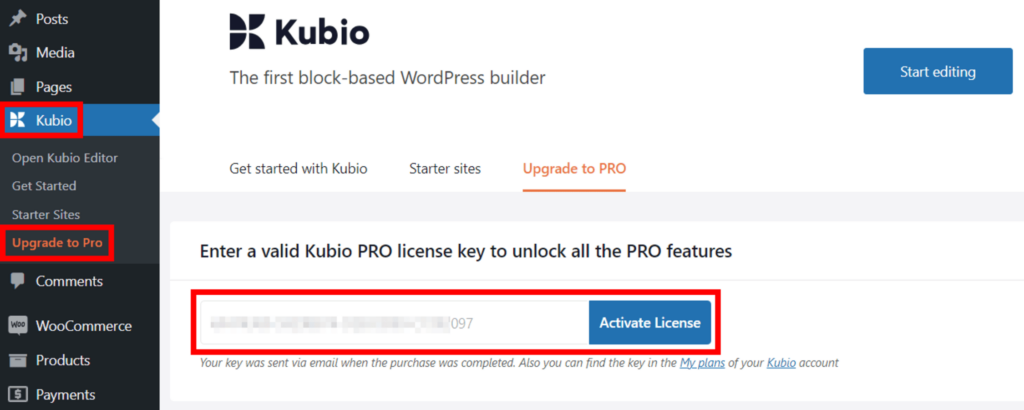
The license key will be sent to your email upon purchase or can be found in the My plans tab from your Kubio account dashboard.
Step 3: Use Kubio’s AI OR use choose a starter site
You can instantly create a bespoke start for your website using Kubio’s new AI feature. You fill in all the details about your site the AI needs to generate the pages – aesthetic style, business type, contact info, etc. – and the AI generates landing page copy, templates, and images to match. Everything’s a first draft – you’ll likely need to do some editing to get things just right – but it gives you an incredible, highly-tailored starting point for your website.
Kubio also offers dozens of beautiful, functional starter sites that you can customize to fit your brand and style. These sites are designed with conversion-friendly blocks and sections that guide your visitors through to your sales page.
The starter sites available in Kubio are suitable for almost every type of online entity, including:
- Business: Kubio’s starter sites come with a modern and professional design, as well as sample content that can be easily customized.
- Blog: Starter sites are perfect for bloggers because they come with a clean and minimal design, and features that make it easy to manage blog posts.
- Portfolio: Freelancers and creative professionals can use the starter sites’ stylish designs to showcase their work neatly.
- Other: Kubio also offers a variety of other starter sites, including sites for churches, restaurants, and eCommerce stores utilizing WooCommerce.
From your WP dashboard, navigate to Kubio > Starter Sites, choose whichever look meets your project’s vision and goals, and click on the Import site button.

You can even preview and try the site before importing it by clicking on the Try Online button.
Step 4: Write compelling sales copy
Great sales copy is what convinces your visitors to make a purchase. Whether you’re writing copy from scratch or editing the AI’s text, you should use the following guidelines to make the most out of your copy:
- Keep it clear and simple: Avoid jargon and complex language.
- Address pain points: Show your visitors how your product or service can solve their problems.
- Consider your brand’s voice: Your sales copy should reflect your brand’s personality.
- Tell a story: Stories can engage your visitors and make your product or service more relatable.
- Emphasize the value of your product: Show your visitors how your products or services can add value to their lives.
- Break up your copy: Use headings, bullet points, and short paragraphs to make your copy easy to read.
- Be positive and encouraging: Encourage your visitors to take the next step and make a purchase.
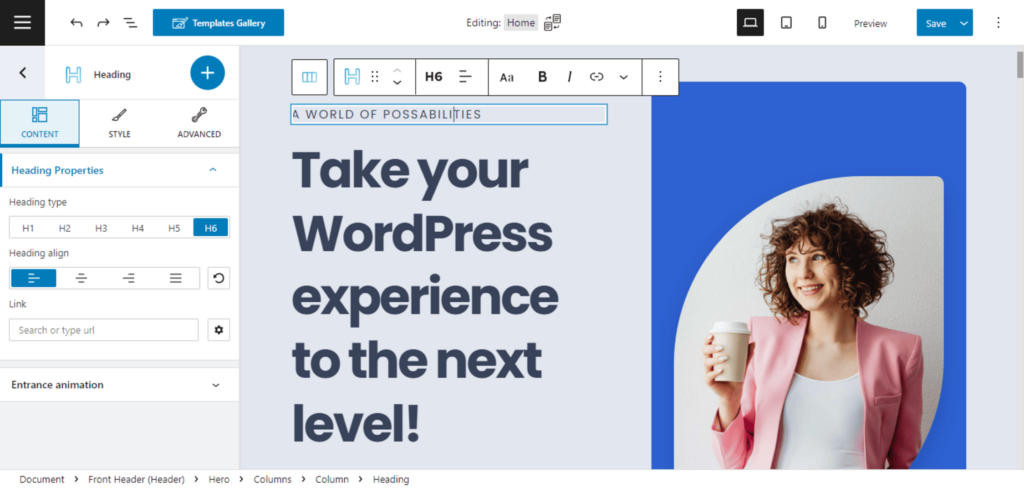

Step 5: Incorporate high-quality images
Images and graphics can greatly enhance your sales page. They can break up long blocks of text, improve readability, and boost conversion rates. Here are some tips for using images on your sales page:
- Use high-quality images: If you have a physical product, consider hiring a professional photographer to take product photos. If you’re using stock photos, make sure they’re high-quality and relevant to your products or services.
- Use appropriate image formatting:
- JPEG for photographs and images with many colors.
- PNG for images with transparency or simple graphics.
- SVG for vector graphics and logos.
- GIF for simple animations or short video clips.
- Use images of people: Images of smiling faces can improve conversion rates. In fact, a study by Visual Website Optimizer found that adding face pictures increased conversions by 48%.
- Use informative graphics: Flow charts, graphs, and infographics can convey information in a visually appealing way.
- Optimize your images: Make sure your images are properly sized and formatted for the web to ensure fast loading times and enhanced overall performance. Smush and EWWW Image Optimizer are useful WordPress plugins for image optimization.
Step 6: Offer social proof
Social proof, in the form of testimonials and reviews, can build trust with your visitors and convince them to make a purchase. 95% of consumers now read reviews online before making a purchase.
Kubio makes it easy to add testimonials and reviews to your sales page with its pre-designed sections.
- Navigate to the Kubio > Open Kubio Editor from your WP admin dashboard.
- Click on the Templates Gallery button at the top.
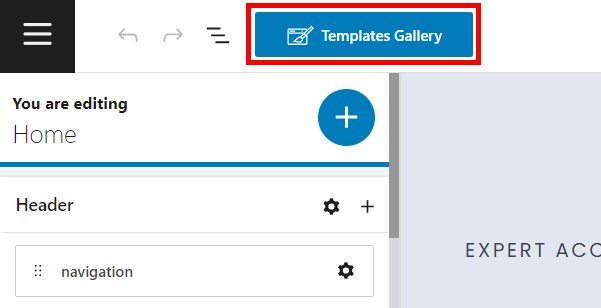
- Click on the Sections at the top, then, from the categories list on the left-hand side, select Testimonials and pick the pre-designed template that best suits your site.
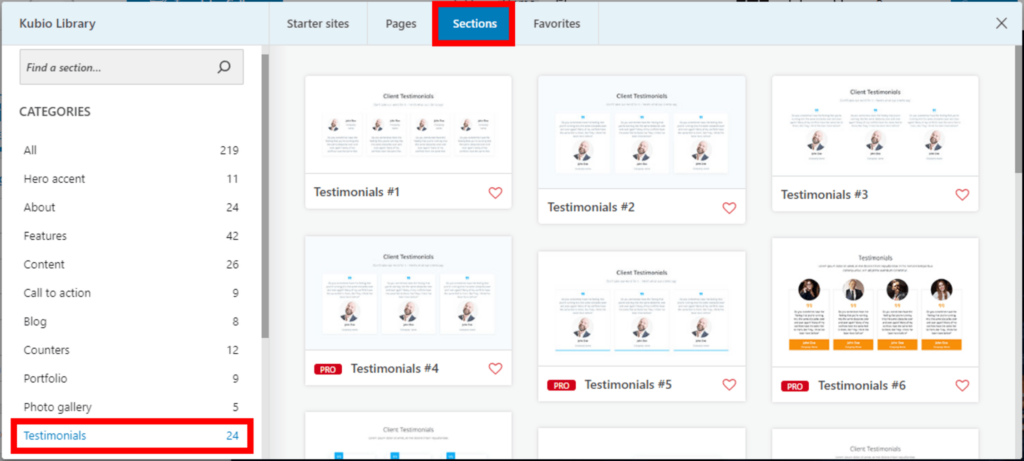
- You can also take it a step further by customizing it however you like from Kubio’s easy-to-use graphical user interface (GUI).
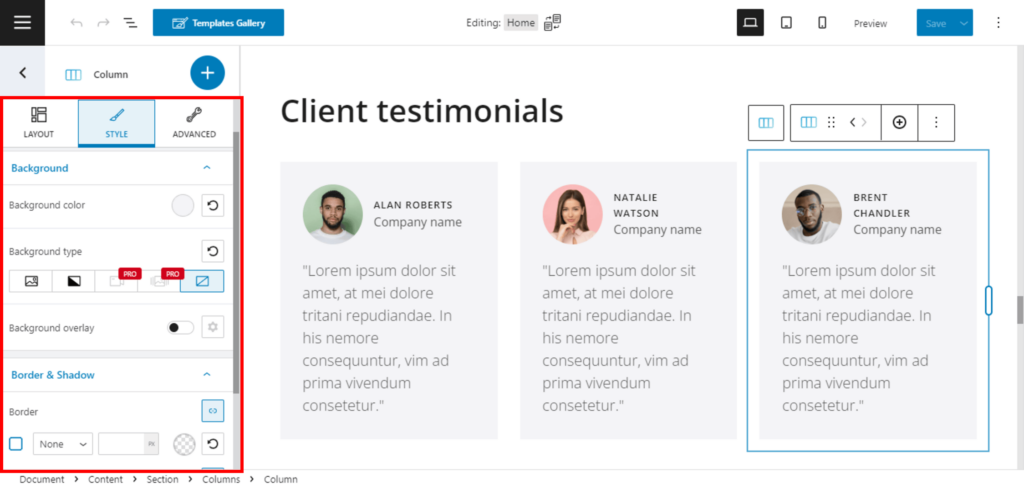
Step 7: End with a strong call-to-action
An impactful call-to-action can outperform clicks from Google Ads. Your sales page should end with a brief and compelling CTA encouraging your visitors to take the next step, whether that’s making a purchase, signing up for a newsletter, or downloading a guide.

That’s it – just click Save at the top-right corner and you’re done! That’s how easy it is to create your WordPress sales page using Kubio.
By following this tutorial, you can build successful pages that engage your visitors, build trust, and drive conversions.
Optimizing your WordPress sales page
There are several ways to optimize your WordPress website, but in this guide, we’ll focus on three key areas: performance optimization, mobile optimization, and search engine optimization (SEO).
Performance optimization
Performance optimization is all about how fast and smoothly your site runs. Slow-loading websites frustrate visitors and lead to a 70% increase in bounce rates.
While Kubio sites are designed to run smoothly, certain choices can slow your page down. Here are some tips to optimize your site’s performance:
- Optimize images: Large, high-resolution images can slow down your site. Make sure your images are properly sized and formatted (refer to step 5).
- Enable browser caching: Browser caching can significantly speed up your site for return visitors. It allows a user’s browser to store copies of your site’s individual pages, so it doesn’t need to retrieve the entire site every time they visit.
- Limit HTTP redirects: While URL redirects can be useful in some cases, excessive redirects can slow down your site. Try to limit the use of redirects as much as possible.
- Stay updated: Regularly update your WordPress themes and plugins. Updates often include performance improvements and can keep your site running smoothly.
Mobile optimization
Mobile optimization ensures your site functions properly on mobile devices. With the growing number of people browsing the web on their phones, mobile optimization is more important than ever.
As of 2023, 79% of smartphone users have made a purchase on their mobile phones.
Kubio has built-in mobile optimization, ensuring your site looks great and works perfectly on all devices. You can also easily preview your site from Kubio’s page editor on different devices to ensure everything is functioning as it should.

SEO optimization
SEO optimization involves designing your website to rank as high as possible in search engine results. While many businesses hire marketing companies to handle their SEO strategy, there are several steps you can take to improve SEO on your own:
- Use strategic keywords: Using the right keywords in your content can help search engines understand what your site is about and rank it accordingly.
- Use headings and blog content: Regularly publishing blog content and using headings correctly can improve your site’s SEO.
- Optimize title tags and meta descriptions: A compelling title tag and meta description can grab a searcher’s attention and get them to click on your site.
- Use descriptive URLs: Where possible, use short, descriptive URLs. These are easier for users and search engines to understand.
- Use analytics: Use analytics tools to track your site’s performance and find data-driven insights to improve your site over time, such as Google Analytics.
Remember, these are just introductory tips. Each of these areas is a vast field on its own, and there’s always more to learn. But by starting with these basics, you can significantly improve your WordPress sales page’s performance, usability, and visibility.
Improve your online marketing strategy with Kubio today
Building a great sales page is an art that combines strategic thinking, attention to detail, and a deep understanding of your product or service. It’s not just about presenting your offerings; it’s about creating a narrative that resonates with your audience and compels them to take action.
Following the steps outlined in this guide, you’ll be well on your way to creating a sales page that captivates your audience and drives conversions. From conducting thorough market research to optimizing your page for performance, mobile, and SEO, each step helps to deliver results.
Even better, you don’t need to be a web developer to create a sensational and effective sales page. With Kubio’s intuitive site builder, you have the power to create functional, conversion-friendly sales pages right at your fingertips.
Don’t let technical hurdles stand in the way of your online success. The journey to a high-converting sales page starts with Kubio. Invest in Kubio’s WordPress site builder today, and start building sales-friendly websites that boost your online marketing strategy and drive your business growth!


